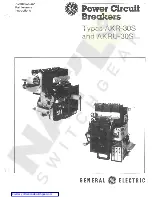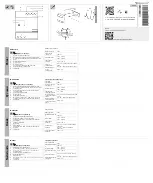
12
Instruction Book
IB182023EN March 2016 www.eaton.com
AMH-4.76-VR
Replacement Circuit Breaker
breaker. If the mark on the interrupter stem is visible, the interrupter
is satisfactory. If the mark is no longer visible, the interrupter
assembly must be replaced.
The erosion indicator is easily viewed from the rear on the 5kV, 7.5kV
or 15kV designs.
WARNING
FAILURE TO REPLACE THE INTERRUPTER ASSEMBLY WHEN INDICATED BY
THE CONTACT EROSION INDICATOR COULD CAUSE THE BREAKER TO FAIL,
LEADING TO DEATH, PERSONAL INJURY OR PROPERTY DAMAGE.
4.1.3 CONTACT WIPE AND STROKE
Contact wipe is the indication of the force holding the vacuum
interrupter contacts closed and the energy available to hammer the
contacts open with sufficient speed for interruption.
Stroke is the gap between fixed and moving contacts of a vacuum
interrupter with the breaker open.
The circuit breaker mechanism provides a fixed amount of motion
to the operating rods. The first portion of the motion is used to
close the contacts (i.e. stroke) and the remainder is used to further
compress the preloaded wipe spring. This additional compression
is called wipe. Wipe and stroke are thus related to each other.
As the stroke increases due to the erosion of contacts, the wipe
decreases. A great deal of effort and ingenuity has been spent in the
design of VR-Series breakers, in order to eliminate any need for field
adjustment of wipe or stroke.
WARNING
THERE IS NO PROVISION FOR IN-SERVICE ADJUSTMENTS OF CONTACT
WIPE AND STROKE. ALL SUCH ADJUSTMENTS ARE FACTORY SET AND
SHOULD NOT BE ATTEMPTED IN THE FIELD.
4.2 PHASE BARRIERS
Phase barriers are sheets of insulation located between the
interrupter pole assemblies and on the sides of the breaker frame.
The phase barriers are designed to isolate energized conductor
components in each phase from the adjacent phase and ground.
WARNING
ALL PHASE BARRIERS MUST BE IN PLACE BEFORE PLACING THE
CIRCUIT BREAKER INTO SERVICE. FAILURE TO HAVE THEM IN POSITION
CAN CAUSE DEATH, SERIOUS PERSONNEL INJURY AND/OR PROPERTY
DAMAGE.
4.3 BUSHINGS AND DISCONNECTING CONTACT
ASSEMBLIES
The line and load bushing assemblies, which are the primary
circuit terminals of the circuit breaker, consist of six silver plated
conductors. Solid stab type primary disconnecting contacts at
the ends of the conductors provide means for connecting and
disconnecting the breaker to the bus terminals in the switchgear
compartment.
4.4 STORED ENERGY MECHANISM
The spring-type stored energy operating mechanism is mounted on
the breaker frame and in the front of the breaker. Manual closing
and opening controls are at the front panel (Figure 3.3). They are
accessible while the breaker is in any of its four basic positions. (See
Section 5 in this manual)
The mechanism stores the closing energy by charging the closing
springs. When released, the stored energy closes the breaker,
charges the wipe and resets the opening springs. The mechanism
may rest in any one of the four positions shown in Figure 4.6 as
follows:
a. Breaker open, closing springs discharged.
b. Breaker open, closing springs charged.
c. Breaker closed, closing springs discharged.
d. Breaker closed, closing springs charged.
The mechanism is a mechanically “trip-free” design. Trip-free is
defined later in this section.
In normal operation the closing spring is charged by the spring
charging motor, and the breaker is closed electrically by the
switchgear control circuit signal to energize the spring release coil.
Tripping is caused by energizing the trip coil through the control
circuit.
For maintenance inspection purposes the closing springs can be
charged manually by using the maintenance tool and the breaker can
be closed and tripped by pushing the “Push to Close” and “Push to
Open” buttons on the front panel.
WARNING
KEEP HANDS AND FINGERS AWAY FROM BREAKER’S INTERNAL PARTS
WHILE THE BREAKER CONTACTS ARE CLOSED OR THE CLOSING SPRINGS
ARE CHARGED. THE BREAKER CONTACTS MAY OPEN OR THE CLOSING
SPRINGS DISCHARGE CAUSING CRUSHING INJURY. DISCHARGE
THE SPRINGS AND OPEN THE BREAKER BEFORE PERFORMING ANY
MAINTENANCE, INSPECTION OR REPAIR ON THE BREAKER.
THE DESIGN OF THIS CIRCUIT BREAKER ALLOWS MECHANICAL CLOSING
AND TRIPPING OF THE BREAKER WHILE IT IS IN THE “CONNECT”
POSITION. HOWEVER, THE BREAKER SHOULD BE CLOSED MECHANICALLY
ONLY IF THERE IS POSITIVE VERIFICATION THAT LOAD SIDE CONDITIONS
PERMIT. IT IS RECOMMENDED THAT CLOSING THE BREAKER IN THE
“CONNECT” POSITION ALWAYS BE DONE WITH THE CUBICLE DOOR
CLOSED. FAILURE TO FOLLOW THESE DIRECTIONS MAY CAUSE DEATH,
PERSONAL INJURY, OR PROPERTY DAMAGE.
ELECTRICAL TRIPPING CAN BE VERIFIED WHEN THE BREAKER IS IN THE
“TEST” POSITION.
4.4.1 CLOSING SPRING CHARGING
Figure 4.5 shows schematic section views of the spring charging
parts of the stored energy mechanism.
The major component of the mechanism is a cam shaft assembly
which consists of a shaft to which are attached two closing spring
cranks (one on each end), the closing cam, drive plate, and a free-
wheeling ratchet wheel.
The ratchet wheel (6) is actuated by an oscillating ratchet lever
(12) and drive pawl (10) driven by the motor eccentric cam. As the
ratchet wheel rotates, it pushes the drive plates which in turn rotate
the closing spring cranks and the closing cam on the cam shaft.
The motor will continue to run until the limit switch “LS” contact
disconnects the motor.
The closing spring cranks have spring ends connected to them,
which are in turn coupled to the closing springs. As the cranks
rotate, the closing springs get charged.
The closing springs are completely charged, when the spring cranks
go over dead center and the closing stop roller (9) comes against the
spring release latch (1). The closing springs are now held in the fully
charged position.
The closing springs may also be charged manually as follows: Insert
the maintenance tool in the manual charging socket. Move it up and
down several times (about 36) until a clicking sound is heard and
closing spring status indicator shows “charged” (Figure 3.3). Any
further motion of the maintenance tool will result in free wheeling of
the ratchet wheel and will not result into advance of charging.








































